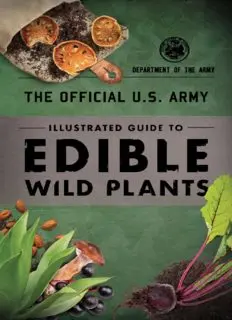
The Official U.S. Army Illustrated Guide to Edible Wild Plants PDF
Preview The Official U.S. Army Illustrated Guide to Edible Wild Plants
THE OFFICIAL U.S. ARMY ILLUSTRATED GUIDE TO EDIBLE WILD PLANTS THE OFFICIAL U.S. ARMY ILLUSTRATED GUIDE TO EDIBLE WILD PLANTS Department of The Army Guilford, Connecticut An imprint of The Rowman & Littlefield Publishing Group, Inc. 4501 Forbes Blvd., Ste. 200 Lanham, MD 20706 www.rowman.com Distributed by NATIONAL BOOK NETWORK Copyright © 2003 and 2019 The Rowman & Littlefield Publishing Group, Inc. All rights reserved. No part of this book may be reproduced in any form or by any electronic or mechanical means, including information storage and retrieval systems, without written permission from the publisher, except by a reviewer who may quote passages in a review. British Library Cataloguing in Publication Information available Library of Congress Cataloging-in- Publication Data available ISBN 978-1-4930-4039-1 (paperback) ISBN 978-1-4930-4040-7 (e-book) The paper used in this publication meets the minimum requirements of American National Standard for Information Sciences—Permanence of Paper for Printed Library Materials, ANSI/NISO Z39.48-1992. Printed in the United States of America TABLE OF CONTENTS Part 1 Edible Plants Plant Identification Universal Edibility Test Edible Plants Part 2 Poisonous Plants Rules for Avoiding Poisonous Plants Contact Dermatitis Ingestion Poisoning Poisonous Plants THE OFFICIAL U.S. ARMY ILLUSTRATED GUIDE TO EDIBLE WILD PLANTS PART 1 EDIBLE PLANTS In a survival situation, plants can provide food and medicine. Their safe usage requires absolutely positive identification, knowing how to prepare them for eating, and knowing any dangerous properties they might have. Familiarity with botanical structures of plants and information on where they grow will make them easier to locate and identify. Plant Identification You identify plants, other than by memorizing particular varieties through familiarity, by using such factors as leaf shape and margin, leaf arrangements, and root structure. The basic leaf margins (see Figure 1.1) are toothed, lobed, and toothless or smooth. These leaves may be lance-shaped, elliptical, egg-shaped, oblong, wedge- shaped, triangular, long-pointed, or top-shaped (Figure 1.2). The basic types of leaf arrangements (Figure 1.3) are opposite, alternate, compound, simple, and basal rosette. The basic types of root structures (Figure 1.4) are the bulb, clove, taproot, tuber, rhizome, corm, and crown. Bulbs are familiar to us as onions and, when sliced in half, will show concentric rings. Cloves are those bulblike structures that remind us of garlic and will separate into small pieces when broken apart. This characteristic separates wild onions from wild garlic. Taproots resemble carrots and may be single-rooted or branched, but usually only one plant stalk arises from each root. Tubers are like potatoes and daylilies and you will find these structures either on strings or in clusters underneath the parent plants. Rhizomes are large creeping rootstocks or underground stems and many plants arise from the “eyes” of these roots. Corms are similar to bulbs but are solid when cut rather than possessing rings. A crown is the type of root structure found on plants such as asparagus and looks much like a mophead under the soil’s surface.
